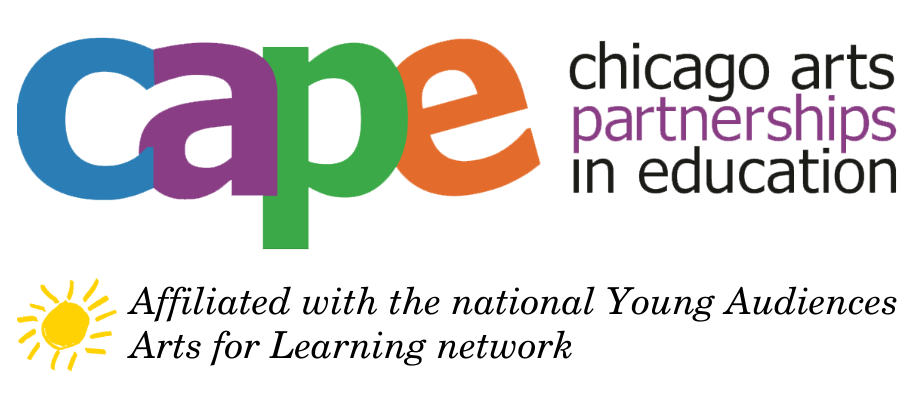Students Pin Their Identity to the Wall and Transform a School
“There’s something to having people invest a little of themselves into a larger piece that makes it more powerful.” -Gwen Terry, CAPE Teaching Artist
Gwen Terry and Gustavo Soto began working together in the fall of 2013 as a part of Chicago Arts Partnerships in Education’s (CAPE) Collaboration Laboratory Program. Gwen, an installation artist, had never worked with third graders before this project. Gustavo, a Chicago Public School teacher at Boone Elementary School in West Rogers Park, had no prior experience in installation art.
In their first meeting at a CAPE professional development session, Gwen and Gustavo shared their current practices with one another, and started to play with different ideas on how to integrate installation art into a third grade social studies curriculum. They then mapped out an instruction plan for their curriculum unit, knowing that they would come back and revise their plan as the project unfolded. 
(Above: First phase of the hallway installation. Students collaborated to create a cityscape to house the artwork that represented their identities and cultures later on in the project. The cityscape represents the students’ impression of where they all live now, and the place where their diverse cultures converge.)
In CAPE classrooms, teachers teach non-arts content areas such as math, language arts, science, etc. At the same time each teaching artist instructs students on techniques and content knowledge related to an arts discipline such as painting, acting, dance, etc. Through planning meetings, CAPE teachers and artists develop an instructional plan that is interdisciplinary and addresses both the arts and non-arts equally.
As partners, the teacher and artist decide on a big idea that will be the central focus of the class project. They then write an inquiry question to guide their investigation of that big idea and challenge themselves and their students to dig deeply into the connections that exist between the arts and academic content. By means of this cross-curricular approach, instructors and students are participating in an artistic investigation.
Last year at Boone Elementary, Gwen and Gustavo set out on such an investigation. In her own practice as an artist, Gwen has an interest in the way installation can transform people’s perceptions of their own environments. She is also interested in collaborative art making processes (i.e. those that involve participation of the audience in the creation of the work). In her own words:
“I feel like there’s something to…having people invest a little of themselves into a larger piece makes it more powerful, and makes it…it creates greater ownership for everyone to the piece. And that’s something I’m very curious about with my work right now, is how can I start to create more and more installations that invite the viewer to interact with it or to be included in with it, that isn’t in a corny or odd way, it’s in a naturalistic way.”
As the classroom teacher, Gustavo was taken by the idea of installation as a basis for his classroom’s social studies unit on identity and culture. He and Gwen envisioned an installation project that would allow students to explore their own identities, their families’ identities, and how different identities and cultures are connected.
These topics of identity and culture are especially relevant because of the highly diverse student body at Boone Elementary (representing all continents and over 30 home languages spoken by students and their families). For a student at Boone, going to school everyday means working with your peers to navigate multiple cultures, languages, and perspectives simultaneously. For Gwen and Gustavo, they wanted to create a project for their students explore what that navigation can look like. They started with an ambitious inquiry question:
How does the transformation of an environment using installation art connect to the understanding and importance of cultural individuality?
In the course of the 12-week residency, the classroom engaged in multiple small artistic projects including mapping, drawing, collage, simple string installations in the classroom, sculpture, and design. All of these “mini” projects required students to do research (on the internet, in books, or by interviewing family members) and synthesize their ideas about culture and identity in order to create their work. The final project was an installation piece in the hallway at the school where students created a cityscape and placed within that the various “mini” projects representing themselves and their cultures. 
(Above photo: As part of the investigation of culture and identity, one of the “mini” projects involved making seedpods)
As Gustavo explains:
“… we were working on the seedpods that were supposed to represent their coming to the country, like a seed kind of flies from one place to another. So when we put our piece together, that was the base of the piece. And then we were adding, each time Gwen came back, a different element to it. So we did a stem that represented heritage. We added the leaves another time, which represented customs. And then the flower was supposed to represent themselves, their identity.”
The installation process itself took many days. Students showed great enthusiasm for the work. In response to the students’ enthusiasm, the teacher and artist contributed several extra volunteer days to the project, which were not formally part of their CAPE residency. There was something they were seeing in the process that was of value to them as well as to their students and the school at large… something was happening as a result of this practice in the classroom that was greater than the sum of its parts. Yes, students demonstrated social studies content understanding though tests and writing assignments. Yes, students learned the technical skills necessary to complete their art project. But the instructors had not accounted for other developments transpiring during this project.
What is the knowledge gained from a CAPE investigation and what does artistic research look like in CAPE classrooms?
Gustavo and Gwen continued investigating their inquiry question: “How does the transformation of an environment using installation art connect to the understanding and importance of cultural individuality?” In the process of doing the work, they noted that not only did students “connect to the understanding and importance of cultural identity,” but they also began to influence the way other teachers in the school thought about their teaching practice.
As the class progressively installed the artwork in the hallway, other teachers in the school took notice: the project took on a life outside of Gustavo’s classroom. A kind of “buzz” came over the school and other teachers adopted installation art as teaching tool in their class projects:
“…typically a teacher will put up a bulletin board and they already know what’s going up there. They put it up and it stays up there, it’s kind of static. The installation piece was something that was changing every time— And I think that was the cool part: the kids knew when we finished that part, it was going up there somehow, and they could see how it was connecting and growing. And the whole school, actually, would always kind of look forward to what’s going up there next.”- Gustavo
The presence of a process-based exhibition in the hallway of the school continued to affect the school by breaking down the traditional school hierarchy. The presence of the installation also allowed for social interactions and information to be exchanged from instructor to instructor, student to student, and even student to instructor:
“[The student] came out and he was wanting to help out, and a teacher came, and she was asking me questions. And all of a sudden he pipes in, and he starts telling her this is what installation art is, this is what this is, this is what that is, to the point that she’s talking to him. I literally- I stepped away. That was the first time that that had ever happened.”
“And I was so blown away by just that sense of ownership and his ability to speak about this… It was really moving for me because it made me really feel like, wow, this is really making an impact. He’s really getting it. And he wasn’t the only one. That was just the first time that I saw that happen.” (Gwen)
There was an impact on the students that went beyond their learning of academic content and artistic techniques. They were beginning to learn about themselves and also how to communicate with others in their class and with the whole school. In creating a safe place to celebrate their diversity, they transformed a public space in their school to a place of personal exchange and dialogue.
In the coming school year, Gwen and Gustavo plan to do their second year of the CAPE’s Collaboration Laboratory program. They are both excited to continue their line of inquiry and see where it leads next:
“For me it really is about discovery. If I knew what was around the corner, why would I go around that corner? So that’s why I’m doing this. It’s curiosity. I’m curious. And I don’t have any set ideas.” -Gwen






